| Home |
| Home |
 Painter unknown | Ippolito de Medici
(1511 - 1535) 
"A Life in the Shadow of the Power" |  Painted by Tiziano Vecellio (1488-1576) |
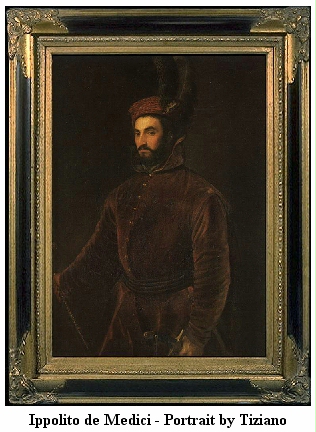
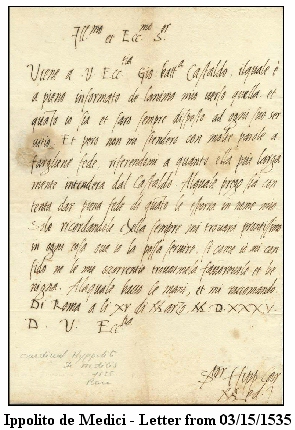 Ippolito
de Medici was born as an illegitimate child probably on March 23, 1511.
His mother was Pacifica Brandani, the daughter of Giovan Antonio Brandani,
and died only few days after the birth. His father was Giuliano de Medici,
a member of the influential family from Florence which lived in exile at
this time.
Ippolito
de Medici was born as an illegitimate child probably on March 23, 1511.
His mother was Pacifica Brandani, the daughter of Giovan Antonio Brandani,
and died only few days after the birth. His father was Giuliano de Medici,
a member of the influential family from Florence which lived in exile at
this time.
Because of social reasons it was not possible for Giuliano to stand
by his child (it is also assumed that Pacifica Brandani was married with
another man at that time) and he decided to give the child into the care
of the brotherhood Santa Maria di Piano where he was called Pasqualino.
A few days later he came to foster father called Bartolomeo from Monteguiduccio
near Urbino. But the little Ippolito remained there only for a brief time
when the reputable notary Lorenzo Spaccioli (possibly on behalf of Giuliano)
took over the custodial care.
When pope Julius II appointed the Medici family in Florence again the
second Renaissance for the family began.
When pope Julius II died in 1513 his follower became Giulianos brother
Giovanni de Medici who called himself pope Leo X.
Ippolito de Medici was brought to Rome where he soon became a well-welcome
guest in the antechamber of the sanctums of pope Leo X.
It followed a time of affluence and Ippolito enjoyed a considerable
education and became a cultured but also ambitious young man. In those
years he got in coutch with the most important personalities of that time,
among others he was portraied by the painter Raphael, moreover he als met
the sculptor Michelangelo when he was creating the tomb for his father
Giuliano who died in 1516. This tomb is still existing. In later years
Ippolito cultivated contacts with Leonardi da Vinci. Es folgte eine Zeit
des Überflusses und Ippolito genoss eine umfangreiche Ausbildung und
reifte zu einem gebildeten aber auch ehrgeizigen Jungen heran. In diesen
Jahren traf er mit den Grössten seiner Zeit zusammen, u.a. wurde er
vom Maler Raphael in einem Bild festgehalten, zudem traf er den Bildhauer
Michelangelo, als dieser für seinen verstorbenen Vater 1516 das Grabmonument
erstellte (dieses existiert auch heute noch). In späteren Jahren pflegte
er Kontakt mit Leonardo da Vinci. His third cousin Caterina de Medici became
later the queen of France and went down into history with the notorius
St. Bartholomew's Day Massacre.
The life of Ippolito became unsure when pope Leo X died in 1521 and
the German Adrian von Utrecht became the new pope as Hadrina VI. But the
curatorship was only short duration when he already died in 1523. It should
last 455 years till the next pope was not an Italian (Pope Johannes Paul
II).
The new pope became Giulio de Medici, a near relative of Ippolotos
father who also renewed the power of the Medici family as pope Clemens
VII. Ippolito on his part could return to the Vatican.
In
1524 Ippolito de Medici was delegated to Florence where he governed the
city cabinet together with Silvio Passerini in order zu prepare him for
future important functions.
With his appearance on the political stage he also became a target
of denunciation of envy opponents and soon his illegitimate birth was part
of the rumors.
The idyll became destroyed in 1527 when adverse troups attacked Rome
and forced the pope to flee. During this attack 147 Swiss guardsmen were
killed and the day went down into history as "Sacco di Roma". In memory
of this 6th May all new Swiss guardsmen take their oath at this day.
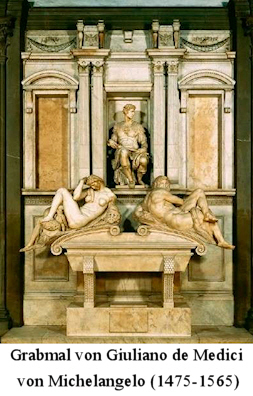 The
Medici family was banished from Florence a second time, Ippolito went together
with his following to Parma.
The
Medici family was banished from Florence a second time, Ippolito went together
with his following to Parma.
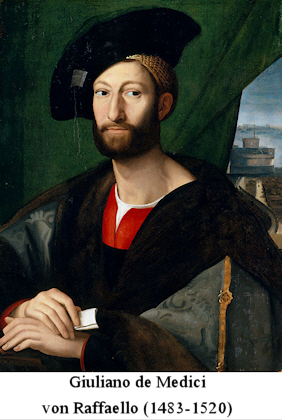
When the conflict mitigated again, pope Clemens VII returned to Rome
and Ippolito followed him. But the pope fell ill seriously and in order
to save the family interests he persuaded Ippolito to take over the cardinal's
hat and in January 1529 Ippolito was ennobled to this position.
In 1531 it became apparent the the power in Florence will change and
Papst Clemens VII planned his illegitimate son Alessandro for this position.
But also Ippolito fancied with this position and he tried to seize the
power. When Alessandro was in Spain, Ippolito rode with his people to Florence.
But the negotiations with the pontifical proconsul Nikolaus Schönberg
failed and Ippolito de Medici had to return to Rome without achived anything.
In order zu reassure Ippolito, pope Clemens VII awarded him with several
functions, among others he became vice chancellor of the Holy Roman Church
on July 3, 1532 and as the legate of the Hungary campaign he started this
campaing on July 8.
In 1534 Ippolito planned again to take over the power in Florence.
But his plans were undone because of the attacks of the Turkish admiral
Barbarossa.
When the pope became fell seriously ill again in 1534 Ippolito was
bound to Rome entirely and after the death of the pope he expressed the
plea in his will to the Spanish imperator that he should suppport his illegitimate
son Alexxandro and arrange the wedding the Margherita of Austria.
With
this will an unfriendly takeover of Florence against Alessandro became
impossible for Ippolito.
Still his hunger for power did not come to a stop and Ippolito de Medici
tried as a substitute of the Florentine opposition to win the imperator
Charles V for his interests.
When Ippolito de Medici felt poorly during a stopover in Fondi in August
1535 on his way to Charles V they guessed malaria as cause. When the caretaker
brought him a chicken stock and Ippolito had to vomit he shouted in the
delirium that he was poisoned and that the Duke Alessandro de Medici had
brought him to death. Hereupon the caretaker was tortured till he made
a confession in order to stop the torture. But as soon as liberated from
the torture he revoked his confession. Ippolito de Medici suffered several
more days before he died in August 10, 1535.
The historians today are at variance what really led to Ippolitos death.
One theory indicates that pope Paul II let him poison, an other that Alessandro
de Medici comes into consideration as agitator. The latter had some reasons
for such an action because only two months before Ippolitos death it became
known that Ippolito had planned an assassination to Alessandro de Medici
by Giambattista Cibo. But also the possibility that Ippolito only died
of malaria is conceivable.
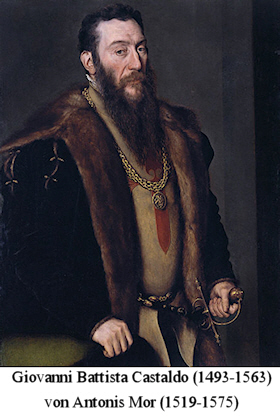 The wording of the reproduced letter reads as follows:
The wording of the reproduced letter reads as follows:
Sincerely and adored Sir
 The bearer, his excellency Gio. Batta Castaldo*, is completely orientated
about my sense for you. I am and will always be at your disposal for your
service. But I won't waste too much words about it, in this regard you
will hear more from Castaldo.
The bearer, his excellency Gio. Batta Castaldo*, is completely orientated
about my sense for you. I am and will always be at your disposal for your
service. But I won't waste too much words about it, in this regard you
will hear more from Castaldo.
Please
give him, who speaks in my name, your full favour.
Only to remember you. You will always and for each matter find me
ready for which I can help you.
I entrust my issues to you and hope to run across you propitious
and gracious.
I kiss your hand of offer my service.
Hipp. Car.
Rome, March 15, 1535
*The referred Giovanni Battista Castaldo in this letter - Marquis von
Cassano - was a captain of the royal army and took part among others in
the battle of Pavia and at the combats in Piemont, Hungary.
Furthermore he led the operation against the Turkies in Transylvania.
.
Other portraits of Ippolito de Medici:
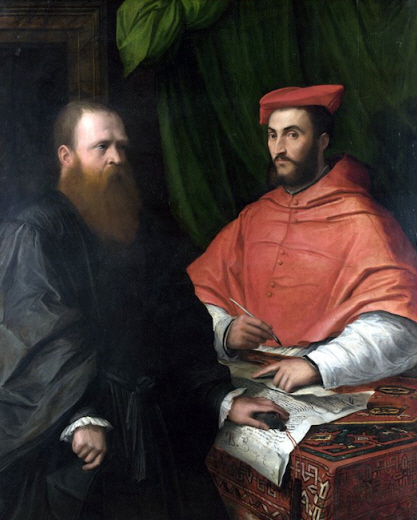 Ippolito de Medici and Mario Bracci, painted by Girolamo da Carpi (1501-1556) | 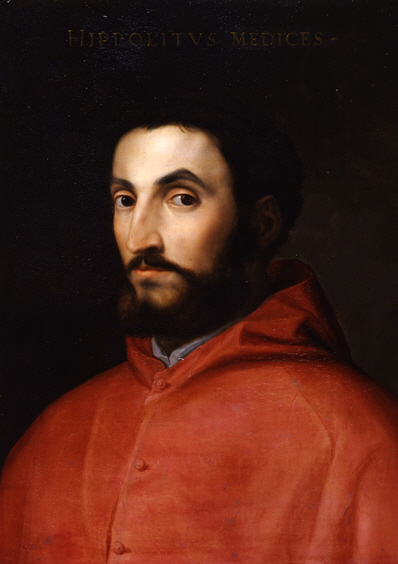 Painted by Cristofano di Papi dell'Altissimo (1525-1605) | 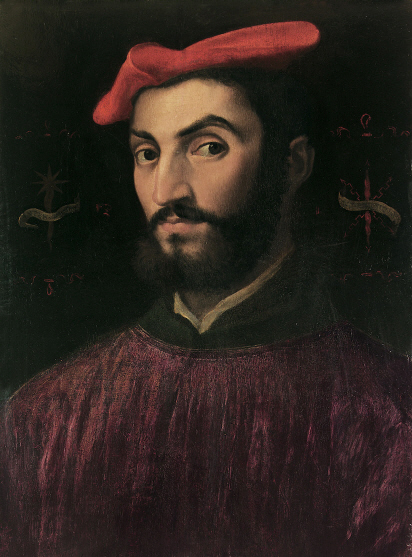 Painted by Sebastiano del Piombo (1485-1547) |
 Painted by Angelo Bronzino (1503-1572) | 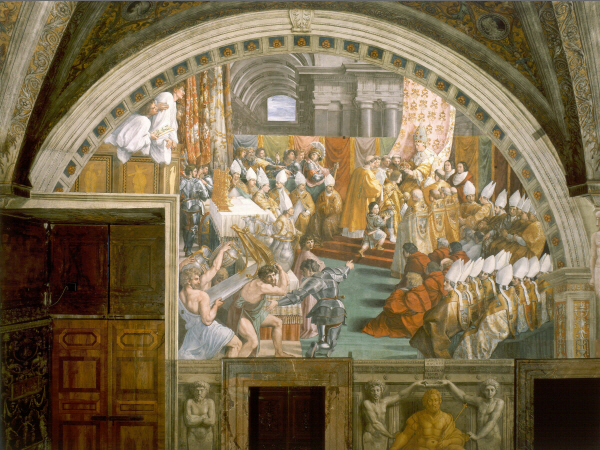 Scene of the coronation of Karl the Great - painted by Raffaello Sanzio da Urbino (1483-1520). Ippolito de Medici was the model for the small boy who kneels on the stairs with a crown in his hand. Part with Ippolito de Medici see right hand side -----> | 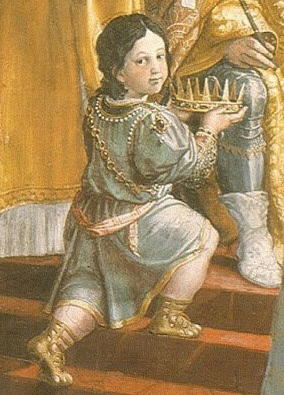 Extract of the coronation with the pictures Ippolito de Medici. |
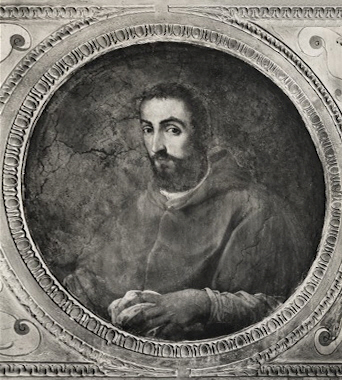 Painted by Giorgio Vasari (1511-1574) |  Engraving by Tobias Stimmer (1539-1584) |  Clemens VII awards Ippolito de Medici the cardinalate |